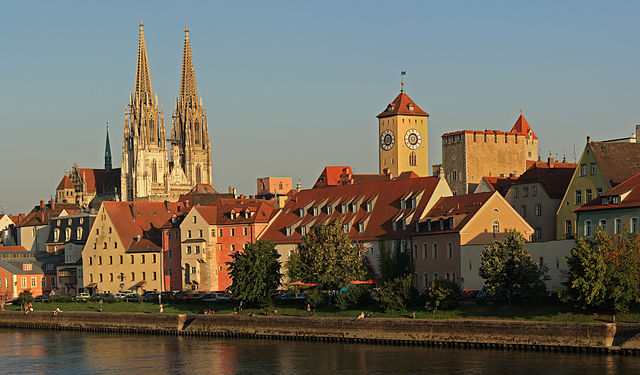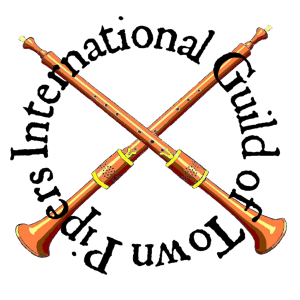Music from the Regensburg Partbooks 1579
16th century music for wind ensemble
Reviewed by Prof. Richard Rastall, 30 July 2016.

The Cathedral of St. Peter and Clock Tower of the Old Town Hall of Regensburg, photographed by Stadtamhof near the Iron Bridge. Between the rooftops one finds numerous family towers from the Middle Ages. The road between the bank and the buildings is called Weinlände.
I have just been given a copy of a new edition of wind music from the late 16th century. It’s in 6 parts and upwards, and I haven’t even tried it out on viols yet: but I think it will be of particular interest to those playing cornetti, sackbuts, bombardes, etc. Town pipers will love it: and although most of our member bands aren’t large enough to play this repertory, times of collaboration (such as festivals) will be ideal for it. I can’t really review the music, not having played any of it, but the composers are all highly reputable: so it’s worth a quick description just to bring it to members’ attention. I’ll leave it to you to post what follows on the Waits website (or not), as you think best.
The music is from the Regensburg manuscript, a set of partbooks completed around 1585 for the wind players of the Archduke Karl of Inner Austria at Graz. The repertory came from various printed sources of (mainly 6-part) vocal music, but it’s clear that it was a great success when performed by the Archduke’s large band of wind players. Of the 120 pieces, nearly half are annotated with the players’ preferred instrumentation: Alessandro Striggio’s 6-part Ecco ch’io lass’ il core, for instance, is noted as being suitable for 3 sackbuts, 2 cornetti and a bombarde, while two sacred motets in 10 parts by Andrea Gabrieli were evidently played on 5 sackbuts, 4 bombardes and 1 cornetto. (Obviously, these are not the only possible instruments.)
It is these pieces with instrumentation noted – 47 of them – that are presented in this edition. Five pieces, all notated in high clefs, are also presented in alternative transposed versions in an appendix. The composers include Lassus, de Monte, Gosswinius, Striggio, de Wert, Padovano, Udental, Langius, Palestrina, Ruffo and Andrea Gabrieli. The work is edited by Douglas Kirk, David Klausner and Daniel Stillman, a team expert in both early-music editing and instrumental performance.
The edition consists of six printed partbooks in a stout cardboard box, plus a flash drive containing files for all the scores (with texts underlaid from the original prints), the introduction and the editorial apparatus. Each partbook contains a short version of the editorial material, so one won’t often need to go to the computer for information. The books are beautifully printed and produced, with a spiral binding that allows them to open out on the music-stand. This is especially necessary for works in more than 6 parts, when two players may be reading from facing pages in a book. (However, the distribution of parts in double-choir music does not always allow a separation of the choirs, and if that is needed – as it should be – some photocopying is required.)
This is all excellent value for US$69, although p&p from the USA will raise that cost considerably unless a UK dealer starts importing it. The edition is published by Amherst Early Music, Inc., and the edition can be bought online at www.amherstearlymusic.org
For enquiries, the email address is [email protected]
Richard
